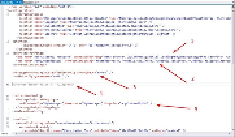Database Reference
In-Depth Information
.CreateBus()
.Start(() =>
Configure.Instance.ForInstallationOn<NServiceBus.Installation.Environments.Windows>()
.Install());
/****
* Send it to the Queue
* ****/
foreach (var msg in myXMLlist)
{
bus.Send(msg);
}
However, this code is really a small piece of the recipe. The
app.config
file plays an
important role in configuring the bus:
1. We will define
NServiceBus/Transport
that will give the SQL connection
string for the queues, which will include the database and connection.
2. The Entity Framework connection string is used to perform other actions on the
database to load tables with utilities outside NServiceBus.
3. The error and audit queues need to be set.
4. A log4net file appender was added to debug.
5. The queue has to be defined based on the messages namespace.
We can see that, when we started the program, the endpoints were created in the
PayQueue
table as follows:

